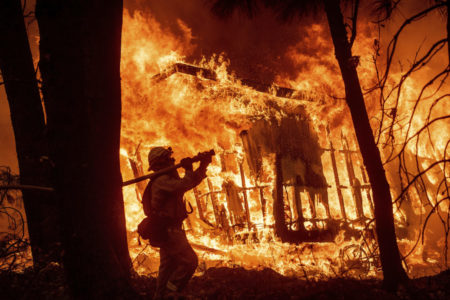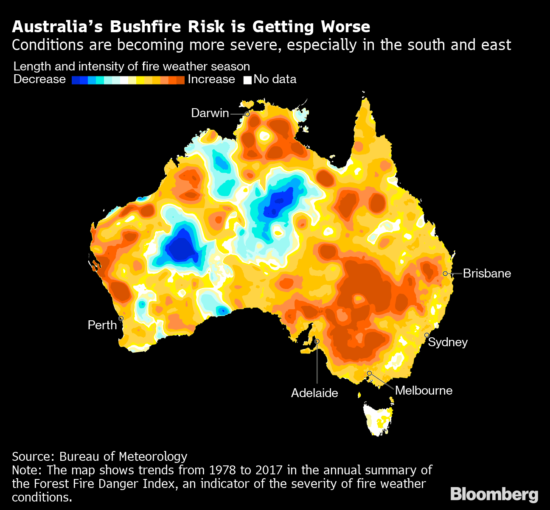November 11, 2019 – There is nothing normal about the increasing incident of wildfires in places like California and Australia. Both have experienced prolonged drought, and both, as a result, are experiencing unprecedented fire events.
See the map below which appeared in a Bloomberg news feed I received today. It depicts where risk of wildfire outbreaks in Australia are increasing because of growing drought conditions. The word “unprecedented” is increasingly associated with what can be seen here.
- Unprecedented high temperatures
- Unprecedented drought conditions
- Unprecedented reductions in long-term rainfall
- Unprecedented low humidity
- Unprecedented wind velocities
- Unprecedented firestorms
These are the same words that describe conditions in California with the word unprecedented appearing in a headline in the Los Angeles Times last month in an article entitled “Unprecedented power outages begin in California as winds bring critical fire danger.” It turns out that Pacific Gas & Electric, (PG&E) California’s largest utility was instituting an unprecedented policy by shutting down power to customers in areas where “widespread dangerous fire weather” was likely to cause wildfires. This had never been done before and was quickly followed by other California utilities who also shut off power to hundreds of thousands of customers.
Greg Mullins of Australia’s Climate Council, and a former Fire and Rescue New South Wales Commissioner, in an opinion piece published in today’s Sydney Morning Herald writes about Australia’s latest outbreak of bushfires stating, “If anyone tells you, ‘this is part of a normal cycle’ or ‘we’ve had fires like this before,’ smile politely and walk away, because they don’t know what they’re talking about.” Australia’s fires are now happening in places where such occurrences have been described as infrequent to non-existent. These areas include the rainforest and old-growth forests of New South Wales, Queensland, and Tasmania.
In New South Wales fires are reportedly creating pyro-convective events. What are they? Also known as pyroCBs they are fire-induced storms that are caused by thermal columns of air laden with ash, blazing wood, vegetation, and water vapour rushing into the sky to form pyro-cumulonimbus clouds topping the stratosphere. PyroCBs are being observed with greater frequency, and climate scientists attribute this to overall global warming. PyroCBs can spawn fire tornados which can send burning embers up to 5 kilometers from the storm source making fighting wildfires from the ground next to impossible. This year has seen pyroCBs in Australia, and California. They have also been observed in British Columbia, Texas, Portugal, South Africa, and Argentina.
California has what it now calls “fire season,” the new norm for the state in the fall and early winter. Fed by two phenomena, the Diablo (Northern California) and Santa Ana (Southern California) winds that can produce gusts reaching top speeds of between 125 and 160 kilometers (approximately 80 to 100 miles) per hour, and combined with low relative humidities of between 1 and 2%, they have created conditions akin to those in Australia.
Mullins describes Australia’s current condition as “more intense than the Millennium Drought,” an event that lasted from 2001 to 2009 and nearly dried up the Murray River Basin, the country’s largest river system. It was so extensive it caused lake levels along the river course to reach one-thousand-year water-level lows. It damaged ecosystems extensively, caused water rationing on farms and in communities, and led to water alerts for Adelaide, South Australia’s largest city.
As of November 1, 2019, California has seen 81,000 hectares (200,000 acres) of its forests and scrublands burn. That’s the bad news. The good news is that the numbers are far lower than the firestorms of last year and are a testament to what has been learned from previous fire seasons. When PG&E, which serves 16 million households, pulled the plug on power to more than one million homes and businesses it was an adaptation and prevention strategy and although it caused considerable public uproar, in fact, it probably prevented a 2018 repeat.
The vigilance and planning for wildfires are now part of California’s DNA, as it should be for much of western North America, Australia, Mediterranean countries, South Africa, and Argentina where climatological conditions are becoming more susceptible to wildfire outbreaks. These unprecedented and growing fire seasons are a phenomenon of human-made and human-worsening conditions. In all of these places, it is becoming a way of life and may foretell a future when conditions there become unlivable.










